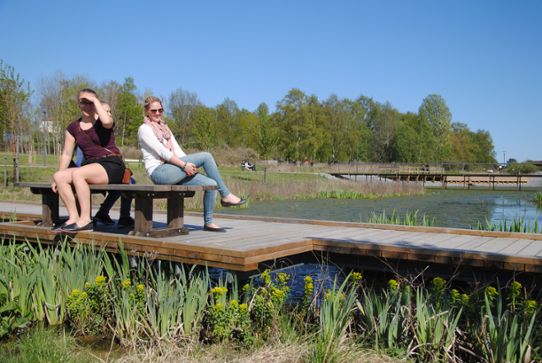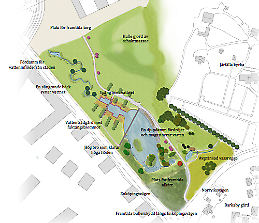The value of ecosystem services is addressed in the comprehensive planning process in Järfälla Municipality and became an important basis of the comprehensive plan that was adopted by the municipal council in 2014. The focus is on preserving ecosystem services in the existing good green structures and developing these by building what is known as a green-blue structure in the urban environment. A green-blue structure integrates the green areas and functions for water management with the built environment. This leads simultaneously to the city being better equipped for future changes in the climate. The park Kyrkparken in the new neighbourhood Barkabystaden was completed in 2014 and was built as part of the effort to regard water as a resource and create a green-blue structure.

Urbanisation and climate change
From a global climate perspective, our cities must become more dense. When this happens, the quantity of hard surfaces increases, leading to problems with polluted surface runoff, increased risk of flooding in the event of heavy rain and a negative impact on health in the event of heat-waves. Exploitation as a result of densification and urbanisation leads to a reduction in the area of green space in cities. This means that urban planning is faced with new challenges in which ecosystem services must be developed so that built-up land is compensated for with green-blue environments. Barkabystaden is no exception. The objective is cities that are economically, socially and environmentally sustainable. Green spaces also have other positive effects, for example with respect to the retardation and purification of surface runoff, but they also help to regulate temperature.
A green-blue structure in the urban environment
By identifying existing ecosystem services and investigating what was required to further improve quality of life, Järfälla Municipality was able to expose the needs that existed and work with them in a tangible way.

Kyrkparken was planned to fulfil several functions. The desire was not just to suppress the detrimental effects of climate change, but also to create a place for social interaction.
The surface runoff infrastructure consists of several ponds, a winding stream, a water garden with a large number of water meadow plants, two bridges and a limestone embankment. The water is cleaned, retarded and stored while being led away from the park area. The natural flow of the stream and the plants also contribute to encouraging the area’s biodiversity.
Costs
The entire facility in Kyrkparken cost SEK 36 million. The municipality contends that by including climate adaptation measures in the plan for the project from the very beginning, it ended up no more expensive than building a normal city park of the same size with similar geological conditions.
The future
The park will be developed further with more functions as Barkabystaden develops. In the future, an alder marsh will be built by the outflow from the ponds in order to remove nitrogen from the water and encourage the area’s biodiversity. As well as noise protection, recreational areas in the form of play parks and barbecue areas are planned for all park visitors.
More examples of climate adaptation
This is one of many examples of climate adaptation. There are more in the collection of ideas being built up by the Swedish National Knowledge Centre for Climate Change Adaptation at the Swedish Meteorological and Hydrological Institute (SMHI). The collection of examples has the aim of sharing experiences and providing ideas to everyone who works with climate adaptation. Examples describe concrete measures and challenges in several subject areas. They show how different actors have worked to adapt their activities to the climate changes that are already being noticed today and those that we cannot prevent in the future.